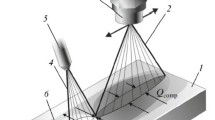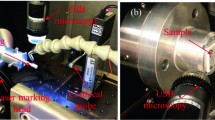Abstract
A new laser machining technique for ceramic shaping, based on the concept of fracture mechanics, is proposed in this paper. The principle of fracture machining technique is investigated. A focused laser is used to scribe two groove-cracks at the two intersecting surfaces of the rectangular substrate. Then, a defocused laser beam is applied throughout the length of the groove-cracks to generate a great thermal stress, which makes the two groove-cracks link together. The material removal is due to the linkage of the groove-cracks. Conventional laser machining requires high laser power to evaporate the materials. The high temperature gradient would induce the formation of micro-cracks, which leads to a remarkable reduction in strength. The laser power required in the method proposed is only a tenth of what is required in the conventional method under the same material removal rate, and in addition, the amount of the micro-crack is smaller. The experimental specimens are alumina ceramics, and the laser sources are a CO2 laser and a Nd:YAG laser. The fracture machining technique can be successfully employed for step shaping and blind corner shaping for a thick ceramic substrate. The relationships of machining parameters such as groove-crack depth, material removal rate, laser scanning speed, and laser power are discussed. Finally, the measurement of the surface roughness and the inspection of crack defects are examined thoroughly.
















Similar content being viewed by others

References
Lumley RM (1969) Controlled separation of brittle materials using a laser. Amer Cer Soc Bullet 48:850–854
Grove FJ, Wright DC, Hamer FM (1970) Cutting of glass with a laser beam. US Patent 3,543,979
Kondratenko VS (1997) Method of splitting non-metallic materials. US Patent 5,609,284
Unger U, Wittenbecher W (1998) The cutting edge of laser technology. Glass 75:101–102
Tsai CH, Liou CS (2003) Fracture mechanism of laser cutting with controlled fracture. ASME J Manufact Sci Engin 125:519–528
Tsai CH, Liou CS (2001) Apply on-line crack detection technique on the laser cutting with controlled fracture technique. Int J Adv Manuf Technol 18(10):724–730
Tsai CH, Chen CJ (2003) Formation of the breaking surface of alumina in laser cutting with controlled fracture technique. Proceedings of the Institute of Mechanical Engineers, Part B. J Engin Manufact 217:489–497
Copley SM, Bass M, Wallace RJ (1978) Shaping silicon compound ceramics with a continuous wave carbon dioxide laser. In: Proceedings of the Second International Symposium on Ceramic Machining and Finishing, NBS, Toronto, Canada
Wallace RJ, Copley SM (1989) Shaping silicon nitride with a carbon dioxide laser by overlapping multiple grooves. J Engin Indust 111:315–321
Chryssolouris G (1986) Stock removal by laser cutting. US Patent 4,625,093
Chryssolouris G, Bredt J, Kordas S, Wilson E (1988) Theoretical aspects of a laser machine tool. ASME J Engin Indust 110:65–70
Hsu RKC, Copley SM (1990) Producing three-dimensional shapes by laser milling. ASME J Engin Indust 112:375–379
Todd JA, Copley SM (1997) Development of a prototype laser processing system for shaping advanced ceramic materials. ASME J Manufact Sci Engin 119:55–67
Sih GC (1974) Strain energy density factor applied to mixed mode crack problems. Int J Fract 10:305–321
Acknowledgments
The authors gratefully acknowledge the financial support provided for this research by the National Science Council (Republic of China) under Grant NSC 89-2212-E-211-004 to Huafan University.
Author information
Authors and Affiliations
Corresponding author
Rights and permissions
About this article
Cite this article
Tsai, CH., Chen, HW. The laser shaping of ceramic by a fracture machining technique. Int J Adv Manuf Technol 23, 342–349 (2004). https://doi.org/10.1007/s00170-003-1679-x
Received:
Accepted:
Published:
Issue Date:
DOI: https://doi.org/10.1007/s00170-003-1679-x



